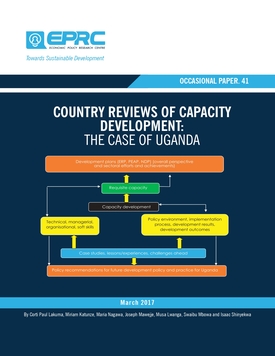Free Access | 2024-04-12
COUNTRY REVIEWS OF CAPACITY DEVELOPMENT: THE CASE OF UGANDA
Authors/Editors: Corti Paul Lakuma , Isaac M.B. Shinyekwa (PhD) , Swaibu Mbowa (PhD) , Joseph Mawejje , Miriam Katunze , Maria Nagawa , Musa Lwanga
Abstract:
Poorly functioning public sector institutions and weak governance are major constraints to growth and equitable development in many developing countries. It is imperative that as Uganda confronts its development challenge, it must address the capacity deficits in the policy environment and implementation for sustainable development results and outcomes. Capacity building is important to Uganda, given the mixed performance that the country has had in the past 30 years. In particular, this study notes success in macroeconomic stability, consolidating security and the restructuring of the government during the Economic Recovery Programme (ERP). Similarly, the Poverty Eradication Action Plan (PEAP) supported poverty reduction by building the capacity of social sectors to expand agricultural production and education and health access. The success of the ERP and the PEAP is largely attributed to donor support in capacity-building effort in institutions such as the Ministry of Finance Planning and Economic Development (MoFPED) and the Bank of Uganda (BoU). However, economic conditions seem to have worsened during the NDP, despite the intensification of infrastructure projects to address production constraints. It costs US$ 0.6 more to buy a unit of electricity in Uganda than in countries such as Rwanda. The growth in agriculture (1.54 percent) is much slower than the growth in population (3.3 percent). This deficit is largely due to the inability of institutions to adapt without donor support to deliver on emerging development issues. In particular, there is scope for improvement in the control of expenditure on large infrastructure projects in the energy and transport sector.
DETAILS

Pub Date: March 2017
Document N0.: 41
Volume: 41
Published By: Economic Policy Research Centre
